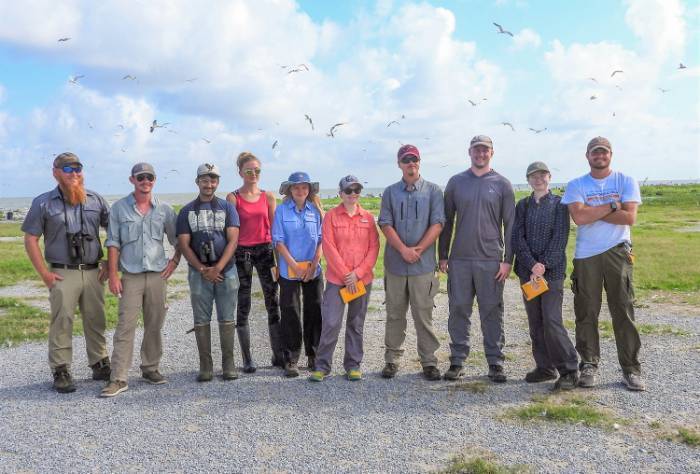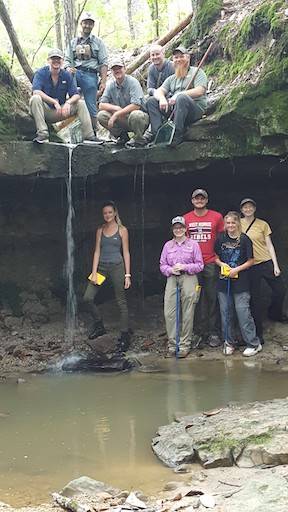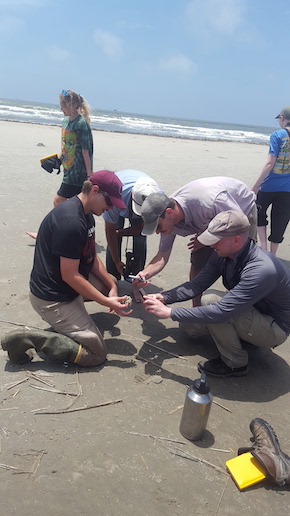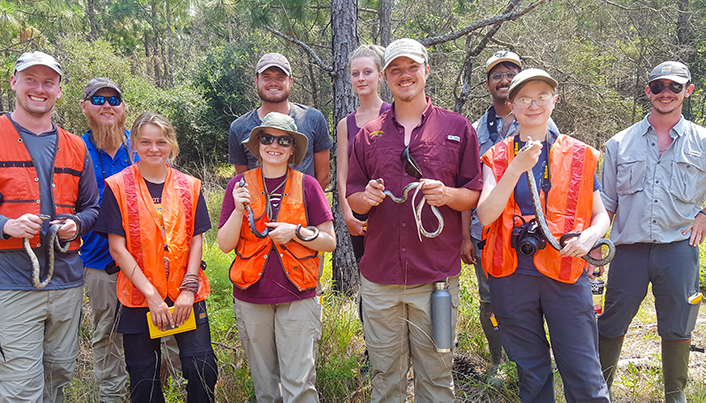

University of Louisiana Monroe field biology students on Queen Bess Island in the Gulf of Mexico, from left, William Moody, Hunter Bertrand, Paurava Thakore, Aaryn Letson, Abbygail Rice, Tara Crow, Gannon Malone, Thomas Showers, Jessica Wright, and Austin Walker. The class traveled by boat with an LDWF biologist to observe colonies of nesting terns and brown pelicans on this restored barrier island northeast of Grand Isle.
ULM photo by Dr. John Carr
By Hope Young
ULM Office of Marketing and Communications
Louisiana, the Sportsman's Paradise and the biologist's dream landscape. In the subtropical climate, three habitats thrive – forests, grasslands, and marshes.
In the summer of 2011, University of Louisiana Monroe field biology students ditched flip-flops for boots and trekked into the wild, following professors of biology, John Carr, Ph.D., and Kim Marie Tolson, Ph.D.
Ten years later, budding biologists continue to study in outdoor classrooms for three weeks in the summer, visiting three "ecoregions" of the state.

University of Louisiana Monroe field biology students visited the waterfalls in Sicily Island at the J.C. Sonny Gilbert Wildlife Management Area. Pictured, from left, at the top are Hunter Bertrand, Paurava Thakore, Gannon Malone, Thomas Showers and William Moody, and below are Kitty Letson, Tara Crow, Austin Walker, Abbygail Rice and Jessica Wright.
ULM photo by Dr. Kim Marie Tolson
"As far as we can tell, no one else in the state is offering this type of class experience. The professional biologists that we meet are constantly telling the students what a unique experience this is for them."
Dr. Kim Marie Tolson
ULM Professor of Biology
"Within ecoregions, we visit the Natural Communities that are defined by the plant species present. For example, on Grand Isle, we visited the Natural Communities of the salt marsh, coastal dunes and beaches, mangroves, live oak/hackberry forest, and coastal dune shrub thicket," Tolson explained.
"Our weekly breakdown consists of one week on the Gulf Coast, one week in the western part of the state in and around Kisatchie National Forest, and one week visiting communities in the northeast part of the state," she said.
A distinctive experience for students
Tolson said she has not found another field-study class of this kind in the state.
"We like to meet up with biologists who live and work in the regions we visit and get them to lead us on 'special' field trips. John Carr and I call upon some of our former ULM students as well as contacts we have made professionally," Tolson said.
"As far as we can tell, no one else in the state is offering this type of class experience. The professional biologists that we meet are constantly telling the students what a unique experience this is for them,” she said.
Summer 2021 students in Field Biology 4051 were Hunter Bertrand, Tara Crow, Aaryn Letson, Gannon Malone, William Moody, Abbygail Rice, Thomas Showers, Paurava Thakore, Austin Walker, and Jessica Wright.
Austin Walker of West Monroe is the son of Matt and Cassie Walker. In Spring 2022, he will graduate with a master’s degree in biology. He described the field biology experience as "… by far the most interesting course I have taken in my time spent as a college student."
"My most enjoyable aspect of the course was being in different environmental communities with my classmates and encountering so many unique species of flora and fauna over the course of the summer one semester because we got to experience Louisiana wildlife with a hands-on approach together as a class," Walker said.
"We had a great, keenly-interested and curious group of students in field biology this summer. It's a fun, learning adventure when traveling with students. We help them gain a greater appreciation for the natural heritage of this state and the country while exploring various portions of Louisiana."
Dr. John Carr
ULM Professor of Biology
Senior Gannon Malone, son of J.D. and Jennifer Malone of Monroe, graduates with a degree in biology in December 2021. After the field biology excursions, Malone has a new appreciation for the environments of the Bayou State.
"This trip opened my eyes to the true biodiversity of our beautiful state. Though our state is smaller than others, the multitude of different plant communities and ecosystems makes each area unique. Simply crossing a river, creek, or ridge can put you in a community completely different than the one you were just in," Malone said.
Studying Grand Isle
The ULM group spent a week on Grand Isle, Louisiana's only inhabited barrier island and a critical habitat for migratory birds, creatures of the chenier forests, and sea life.
Carr, who holds the Lillian L. & Fred A. Marx Endowed Professorship in Biology, said Grand Isle was a new location for the class "… and bursting with new sights and sounds every day."
"We had a great, keenly-interested and curious group of students in field biology this summer. It's a fun, learning adventure when traveling with students. We help them gain a greater appreciation for the natural heritage of this state and the country while exploring various portions of Louisiana," Carr said.
The Grand Isle Port Commission assisted the students in gaining access to the rarely reached Queen Bess Island, a Louisiana Department of Wildlife and Fisheries refuge, and worked with The Nature Conservancy.

"The Grand Isle Port Commission welcomed this opportunity to assist and support the biology education system," said Weldon Danos, executive director of the Grand Isle Port Commission. "It was a pleasure providing a location for these college students to perform their sampling process, along with the Grand Isle Nature Conservancy and State Park. We were also glad that our island provided students a unique environment to conduct research and enjoy their summer."
Incredible nature
ULM students conducted small mammal population research using small live traps to capture and release specimens on the port's property, including marsh and mangroves along Barataria Bay, adjacent to the oyster hatchery and kayak launch.
"Our fieldwork in Grand Isle introduced our students to the process of field sampling, data collection, and animal and plant identification," said Tolson, director of the ULM Museum of Natural History.
"This trip opened my eyes to the true biodiversity of our beautiful state. Though our state is smaller than others, the multitude of different plant communities and ecosystems makes each area unique."
Gannon Malone
Senior biology student
"Graduate students gained valuable leadership skills directing the undergraduates. It allowed all students to apply the knowledge they have acquired in the classroom to a situation similar to what practicing field biologists may experience. Students will turn in a report on the trapping techniques and the results of their efforts," she said.
"During week two of our field bio trip, we visited Grand Isle, and I would love to go back. The nature there was incredible. Species differed so drastically just by occupying saltwater, brackish, or freshwater," Walker said.
Live animal traps baited with sunflower seeds were checked twice a day. The rodents caught were identified, recorded, and then released. Students also conducted surveys for mammals, reptiles, and amphibians on The Nature Conservancy's 41-acres. Shorebird identification surveys were conducted at Grand Isle State Park.
"Serving as professional biologist guides and working with local biologists and experts gives them a taste for the nature of working outdoors as a biologist. I think it has the potential to be a uniquely inspiring experience for developing biologists," Carr said.
"… by far the most interesting course I have taken in my time spent as a college student."
Austin Walker
Graduate student in biology
There's more
Malone, whose father is ULM head track coach, preferred searching for snakes over shorebirds.
"My favorite part of the trip was being able to check drift fence snake traps, set to catch the rare and elusive Louisiana Pine Snake in Bienville Parish," Malone said.
"This experience was so fun, as we got to handle snakes such as Coachwhips, Western Rat Snakes, Buttermilk Racers, and even a Western Mud Snake. Along with these snakes, we also caught Texas Tarantulas, Six-lined Racerunners, and Common Five-lined Skinks," he said.
Kisatchie National Forest in central Louisiana was his favorite.
"Before I visited there, I had only driven through it on my way to southeast Texas and labeled it as a pine forest, and nothing more. But after getting out of the van and exploring the forest, I realized that it had so much more to offer with pitcher plant bogs and crystal-clear creeks, just to name a few," he said.

The University of Louisiana Monroe Field Biology 4051 students hold snakes caught in Kisatchie National Forest. The class, led by John Carr, Ph.D., and Kim Marie Tolson, Ph.D., professors of biology, spent three weeks traveling Louisiana for hands-on experience in nature.
ULM photo by Dr. John Carr